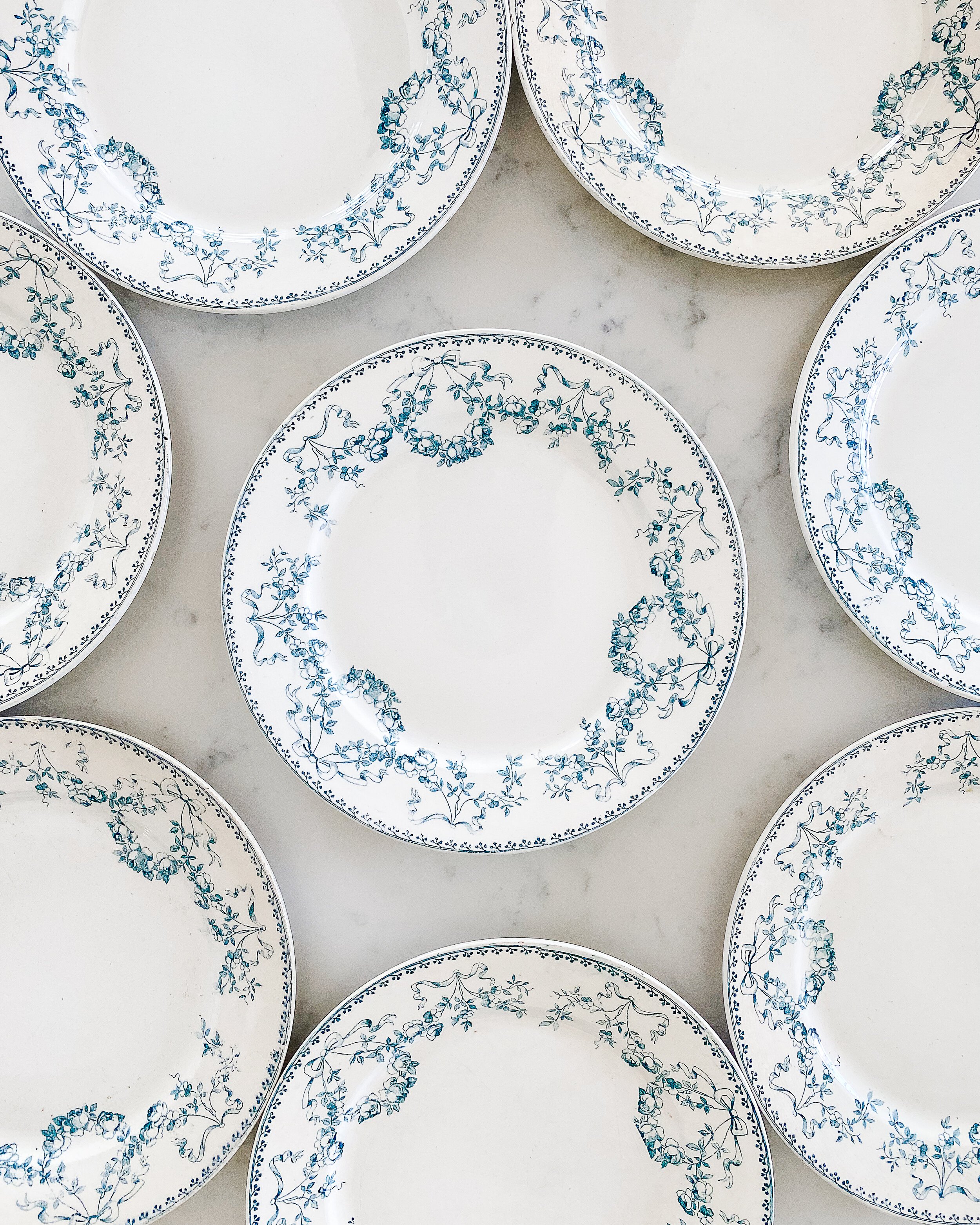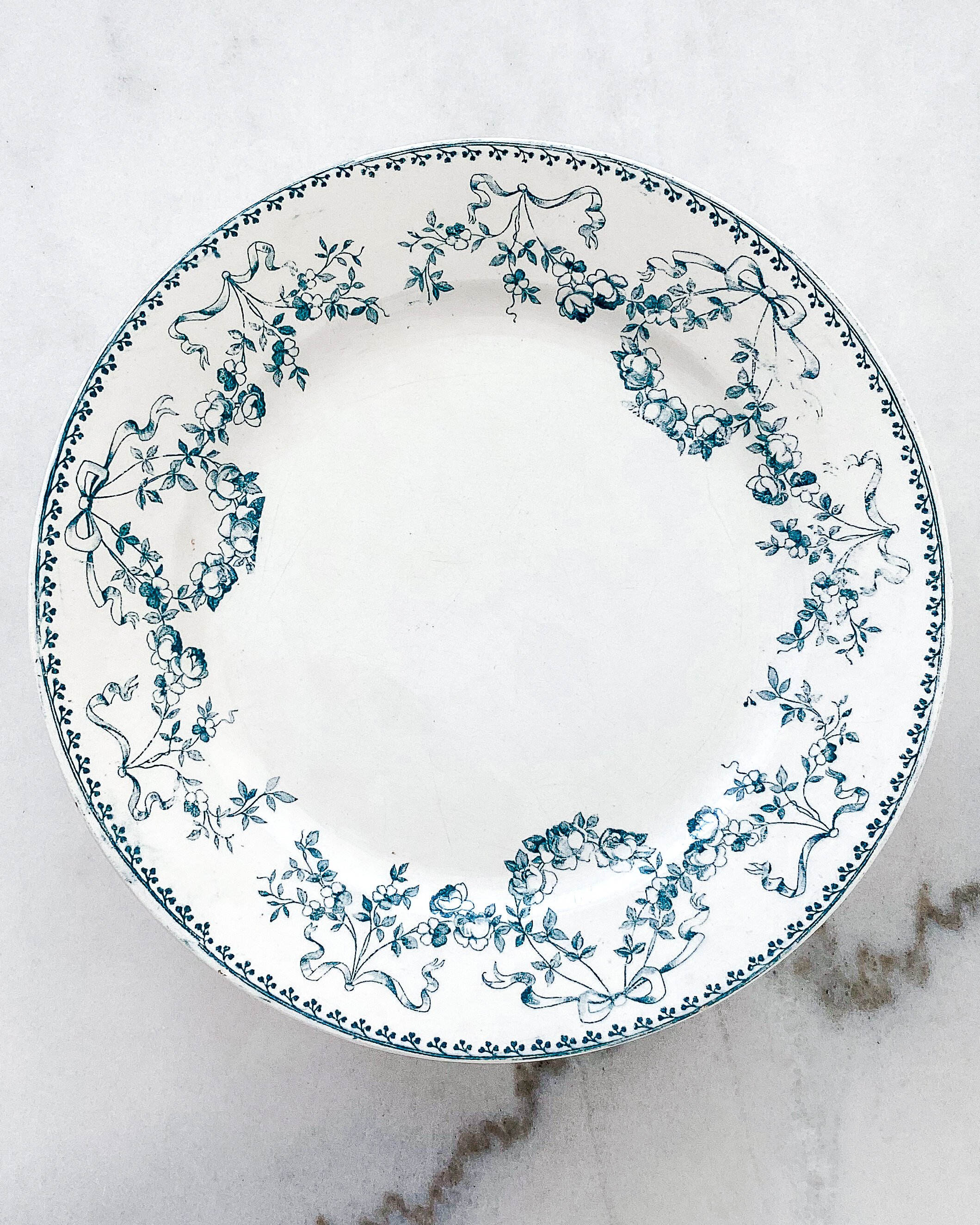Sarreguemines Mozart Plates (Set of 8)
A set of 8 vintage French faience (earthenware with an opaque white glaze) dinner plates with a lovely antique blue transferware pattern featuring a gorgeous blue floral and ribbon motif. The plates’ pattern, "Mozart", from U & C Sarreguemines (Utzschneider and Co), one of the best known faience manufactures in France, dates to the early 1900s.
Transferware, which got its start in Italy in the late 17th century, is glazed ceramic ware decorated using an engraved copper or steel plate, which is printed onto paper and then transferred onto a ceramic piece. French faience came into being in 1689 when King Louis XIV needed money and taxed tableware made of gold and silver.
History of Sarreguemines Pottery: In 1790, despite the unfavorable economic climate of the Revolution, Nicolas-Henri Jacobi and two partners set up the first faience factory in the commune of Sarreguemines. The city was brought to the top of the earthenware industry with their collections of earthenware, vases, flowerpots and wall frescos, which drew Napoleon I to become one of the factory’s major customers. The factory was so well known that they supplied most of the original tiles used to decorate the walls of the Paris metro! During the 2nd World War, the factory was seized and managed by Villery & Boch. After the war the Sarreguemines factory went on to specialize in the production of ceramic floor and wall tiles and in 1979 their production of faience came to an end.
Found in France
Underside is stamped with “H” and “3 25 F”
Small chip on edge of one plate
Plates contain some minor crazing and staining
Overall condition consistent with age and use
Each plate measures approximately 9” W x .75” H
Available for pick up, local delivery, and nationwide shipping.
Need help with an item? Email Us
Request a trade discount here.
A set of 8 vintage French faience (earthenware with an opaque white glaze) dinner plates with a lovely antique blue transferware pattern featuring a gorgeous blue floral and ribbon motif. The plates’ pattern, "Mozart", from U & C Sarreguemines (Utzschneider and Co), one of the best known faience manufactures in France, dates to the early 1900s.
Transferware, which got its start in Italy in the late 17th century, is glazed ceramic ware decorated using an engraved copper or steel plate, which is printed onto paper and then transferred onto a ceramic piece. French faience came into being in 1689 when King Louis XIV needed money and taxed tableware made of gold and silver.
History of Sarreguemines Pottery: In 1790, despite the unfavorable economic climate of the Revolution, Nicolas-Henri Jacobi and two partners set up the first faience factory in the commune of Sarreguemines. The city was brought to the top of the earthenware industry with their collections of earthenware, vases, flowerpots and wall frescos, which drew Napoleon I to become one of the factory’s major customers. The factory was so well known that they supplied most of the original tiles used to decorate the walls of the Paris metro! During the 2nd World War, the factory was seized and managed by Villery & Boch. After the war the Sarreguemines factory went on to specialize in the production of ceramic floor and wall tiles and in 1979 their production of faience came to an end.
Found in France
Underside is stamped with “H” and “3 25 F”
Small chip on edge of one plate
Plates contain some minor crazing and staining
Overall condition consistent with age and use
Each plate measures approximately 9” W x .75” H
Available for pick up, local delivery, and nationwide shipping.
Need help with an item? Email Us
Request a trade discount here.
A set of 8 vintage French faience (earthenware with an opaque white glaze) dinner plates with a lovely antique blue transferware pattern featuring a gorgeous blue floral and ribbon motif. The plates’ pattern, "Mozart", from U & C Sarreguemines (Utzschneider and Co), one of the best known faience manufactures in France, dates to the early 1900s.
Transferware, which got its start in Italy in the late 17th century, is glazed ceramic ware decorated using an engraved copper or steel plate, which is printed onto paper and then transferred onto a ceramic piece. French faience came into being in 1689 when King Louis XIV needed money and taxed tableware made of gold and silver.
History of Sarreguemines Pottery: In 1790, despite the unfavorable economic climate of the Revolution, Nicolas-Henri Jacobi and two partners set up the first faience factory in the commune of Sarreguemines. The city was brought to the top of the earthenware industry with their collections of earthenware, vases, flowerpots and wall frescos, which drew Napoleon I to become one of the factory’s major customers. The factory was so well known that they supplied most of the original tiles used to decorate the walls of the Paris metro! During the 2nd World War, the factory was seized and managed by Villery & Boch. After the war the Sarreguemines factory went on to specialize in the production of ceramic floor and wall tiles and in 1979 their production of faience came to an end.
Found in France
Underside is stamped with “H” and “3 25 F”
Small chip on edge of one plate
Plates contain some minor crazing and staining
Overall condition consistent with age and use
Each plate measures approximately 9” W x .75” H
Available for pick up, local delivery, and nationwide shipping.
Need help with an item? Email Us
Request a trade discount here.















